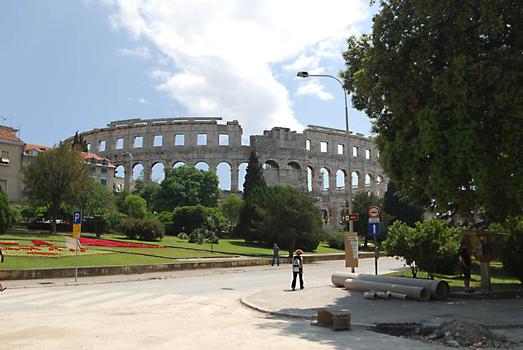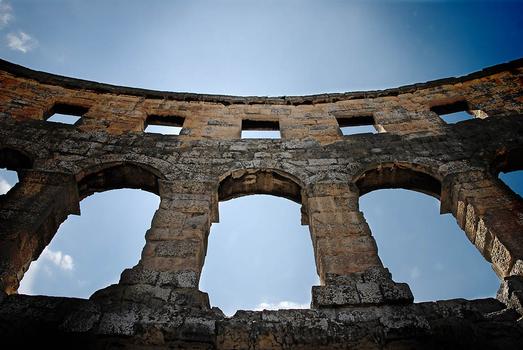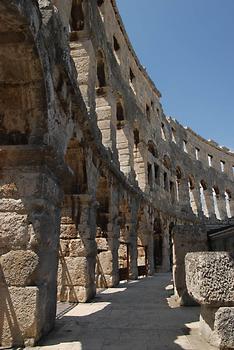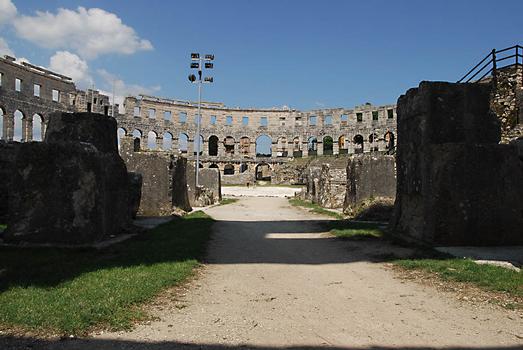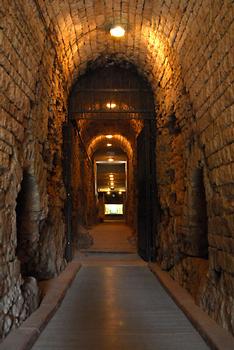General Information
Project Type
| Function / usage: |
Amphitheater |
|---|---|
| Plan view: |
Structurae Plus/Pro - Subscribe Now! |
| Material: |
Masonry structure |
| Architectural style: |
Roman |
Location
Technical Information
Dimensions
| width | 105.10 m | |
| height | 32.5 m | |
| length | 132.45 m | |
| arena | width | 41.65 m |
| length | 67.95 m | |
| cavea | seats | 23 000 |
Materials
| exterior walls |
limestone
|
|---|
Excerpt from Wikipedia
The Pula Arena (Croatian: Pulska Arena; Italian: Arena di Pola) is a Roman amphitheater located in Pula, Croatia. It is the only remaining Roman amphitheater to have four side towers entirely preserved. It was constructed between 27 BC and AD 68, and is among the world's six largest surviving Roman arenas. The arena is also the country's best-preserved ancient monument.
The amphitheater was depicted on the reverse of the Croatian 10 kuna banknote, issued in 1993, 1995, 2001, and 2004.
History
The Arena was built between 27 BC and 68 AD, as the city of Pula became a regional center of Roman rule, called Pietas Julia. The building is named after the sand (Latin harena) that once covered the inner, performance area. It was built outside the town walls along the Via Flavia, the road from Pula to Aquileia and Rome.
The amphitheater was first built in timber during the reign of Augustus (2–14 AD). It was replaced by a small stone amphitheater during the reign of emperor Claudius. In 79 AD it was enlarged to accommodate gladiator fights by Vespasian and to be completed in 81 AD under emperor Titus. This was confirmed by the discovery of a Vespasian coin in the malting.
St. Germanus, of whom little is known, was allegedly tortured in the Amphitheatre in or around 290, and subsequently martyred outside the city, on the road to Nesactium. The legend is apocryphal. The amphitheater remained in use until the 5th century, when emperor Honorius prohibited gladiatorial combats. It was not until 681 that combat between convicts, particularly those sentenced to death, and wild animals were forbidden. In the 5th century, the amphitheater began to see its stone plundered by the local populace. By the 13th century, the patriarch of Aquileia forbade further removal from the Arena.
Construction
The exterior wall is constructed in limestone. The part facing the sea consists of three stories, while the other part has only two stories since the amphitheater was built on a slope. The maximum height of the exterior wall is 29.40 m (96.5 ft). The first two floors have 72 arches each, while the top floor consists of 64 rectangular openings.
The axes of the elliptical amphitheater are 132.45 and 105.10 m (434.5 and 344.8 ft) long, and the walls stand 32.45 m (106.5 ft) high. It could accommodate 23,000 spectators in the cavea, which had forty steps divided into two meniani. The seats rest directly on the sloping ground; The field for the games, the proper arena, measured 67.95 by 41.65 m (222.9 by 136.6 ft). The field was separated from the public by iron gates.
Exterior during the blue hour
The arena had a total of 15 gates. A series of underground passageways were built underneath the arena along the main axis from which animals, ludi scenes and fighters could be released; stores and shops were located under the raked seating. The amphitheater was part of the circuit of the gladiators.
Each of the four towers had two cisterns filled with perfumed water that fed a fountain or could be sprinkled on the spectators. The amphitheater could be covered with velaria (large sails), protecting the spectators from sun or rain (as attested by rare construction elements). Below the arena was a system of canals that collected rainwater and effluent and drained them into the sea.
This amphitheater, through its conservation, has served as an example for the study of ancient building techniques.
Later use
In the Middle Ages, the interior of the Arena was often used for grazing, occasional tournaments by the Knights of Malta and medieval fairs. In 1583 the Venetian Senate proposed dismantling the arena and rebuilding it within Venice. The proposals were rejected. Today, a headstone celebrating the Venetian senator Gabriele Emo's [sh] opposition to the plan is currently visible on the second tower.
In 1789, stone was taken from Pula arena for the belfry foundations at Pula Cathedral. This was the last time the arena was used as a source of stone.
Restoration
General Auguste de Marmont, as governor of the Illyrian Provinces during the First French Empire, started the restoration of the arena. This was continued in 1816 by the Ticinese architect Pietro Nobile, commissioned by the emperor Francis I of Austria.
In 1932, the arena was adapted for theatre productions, military ceremonies, and public meetings. In its present state, seating capacity is around 7,000 and 12,500 for all standing events.
Present day
The arena is used as a venue for many concerts. Performances have included ones by Foo Fighters, Luciano Pavarotti, Đorđe Balašević, Plácido Domingo, Andrea Bocelli, Patrizio Buanne, Jose Carreras, Dino Merlin, Jamiroquai, Anastacia, Eros Ramazzotti, Maksim Mrvica, Norah Jones, Zucchero, Zdravko Čolić, Alanis Morissette, Sinéad O'Connor, Elton John, 2Cellos, Sting, Michael Bolton, Seal, Il Divo, Tom Jones, Gibonni, Manu Chao, Oliver Dragojević, Leonard Cohen, Grace Jones, Moderat, David Gilmour, Arctic Monkeys, and Frank Zivkovic. It has a capacity of about 5000 spectators, and also hosts operas, ballets, sports competitions as well as the Pula Film Festival. The arena is open to the public daily, and the underground passages house exhibitions of viticulture and olive growing in Istria.
The arena has also been used for cinematic works such as Titus, a 1999 film adaptation of Shakespeare's revenge tragedy Titus Andronicus by Julie Taymor. On July 8, 2019; a football match was played between the former players of FC Bayern Munich and Croatia national football team as part of a tourism partnership deal between FC Bayern Munich and the Istria Tourist Board signed in 2018. Two professional ice hockey games were played there on September 14 and 16, 2012; KHL Medveščak, a Zagreb-based Erste Bank Eishockey Liga club, hosted HDD Olimpija Ljubljana and the Vienna Capitals.
Text imported from Wikipedia article "Pula Arena" and modified on February 14, 2023 according to the CC-BY-SA 4.0 International license.
Participants
Currently there is no information available about persons or companies having participated in this project.
Relevant Web Sites
Relevant Publications
- (1951): La forme de l'amphithéatre de Pola. In: Bulletin technique de la Suisse romande, v. 77, n. 13 (30 June 1951).
- About this
data sheet - Structure-ID
20028211 - Published on:
30/05/2007 - Last updated on:
11/02/2023


